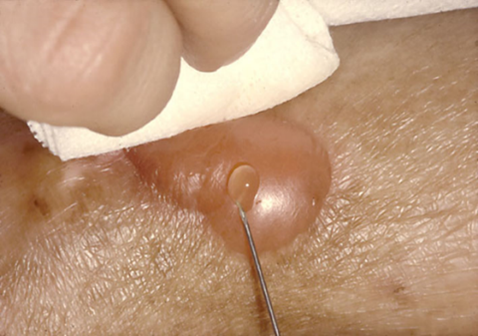
https://www.gosh.nhs.uk/conditions-and-treatments/conditions-we-treat/epidermolysis-bullosa-eb-blister-management-and-dressings/
Epidermolysis bullosa (EB): blister management and dressings
This webpage explains about managing blisters and dressings.
How should I manage blisters?
It’s important to pop blisters to stop them from getting bigger.
- Use a piece of soft gauze to gently compress the blister from the side to increase tension.
- Use a small hypodermic sterile needle (or small clean sharp scissors) to pierce the blister.
- Slide the needle through the blister to create an entry and exit point. If the blister is large, you may need to do this more the once.
- Withdraw the needle and gently press the blister with the gauze to remove the fluid.
- Dispose of the needle into a sharps bin.
- You don’t need to use a dressing if the top of the blister is still in place.
- Use a dressing if there is skin loss or if the area looks particularly sore.

Popping a blister
How should I care for wounds?
- Apply dressings to sore and open wounds to encourage healing and to prevent wounds sticking to clothing. You can use a silicone-based dressing.
- Sticky dressings such as plasters are likely to damage your child’s skin, so use EB safe (silicone based) dressings and tapes where possible.
- When using non-sticky dressings take care not to use a sticky tape to stick these to the skin. Instead, where possible, wrap the dressing and stick it to itself. Use a silicone-based tape if needed to secure to the skin.
- Retention garments can be used to keep dressings in place, especially over hard to dress areas.
- If the skin is particularly sore, cleanse the skin with an antimicrobial wash. Otherwise, a non-scented gentle wash can be used.
- Remove any sticky dressings with a non-sting adhesive remover to ensure safe removal. The adhesive removal spray will melt away the sticky layer on the dressing and will lift the dressing off the wound safely without causing further damage.
I’m worried that a wound is infected, what should I do?
You can treat infected wounds with creams and ointments and/or dressings. However, if your child has a fever, you should contact your child’s GP- they may need antibiotics to help treat the infection. Please ask the GP to take a wound swab before prescribing antibiotics.
If you are concerned about your child’s wounds, please contact the EB nursing team to discuss the best treatment options.
Contact us
If you are at all concerned about any skin changes, please contact your EB team as soon as possible.
· Message us on MYGOSH
· Call us on 0207 405 9200 Ext 5053
· Email us on gos-tr.ebnurses@nhs.net
Where can I get further support?
DEBRA and Cure EB are the national charities that support individuals and families affected by EB.
They provide information, practical help and professional advice, and fund research into the condition. To find out more please visit the DEBRA website and the Cure EB website.